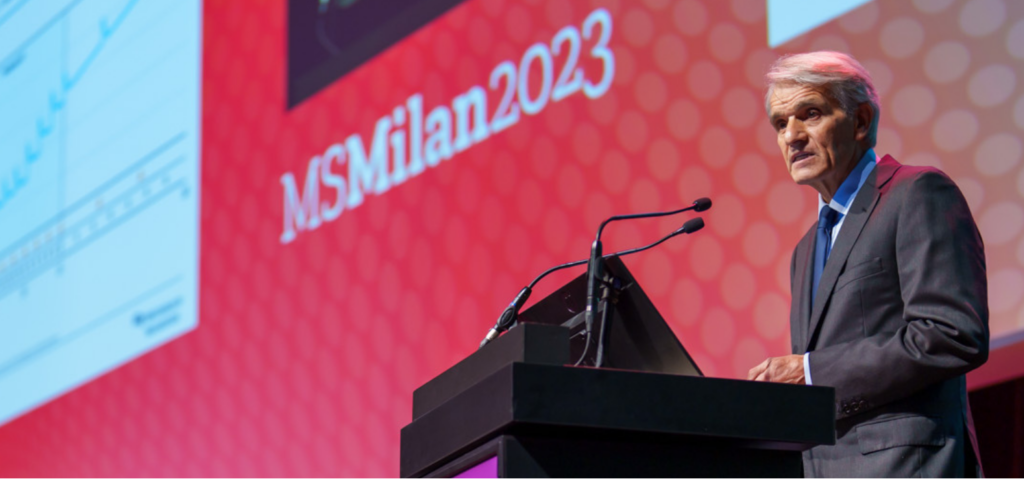
Growing understanding of the pathology and underlying mechanisms of MS has brought the prospect of a cure closer than ever, but there is still work to be done.
That’s according to Stephen Hauser, professor of neurology at the University of California, San Francisco (UCSF), who gave the ECTRIMS lecture at MSMilan2023.
“MS is one of the two or three great success stories of modern molecular medicine. We are halfway home, but we are not all the way there,” he told the meeting, held in Milan from 11 to 13 October, adding that the community had “an immense opportunity to advance from partial to complete suppression, to cure”.
Informing earlier treatment
Disability is usually irreversible, so the earlier we can treat MS, the more likely it is that we can achieve “maximum and complete control”, said Prof Hauser.
To date, the research community has made little progress in identifying the earliest triggers with any specificity. Now, however, researchers are starting to shine a light on the premonitory phase, and on a specific MS signature.
Genetics plays a role, but it does not tell the full story. Work from the International Multiple Sclerosis Genetics Consortium has identified more than 230 loci associated with MS susceptibility, the majority of which are in the vicinity of genes that affect blood or immunity cells. However, these have only a negligible effect on disease severity, said Prof Hauser, explaining that the severity loci cluster in genes that are central nervous system (CNS) expressed.[i] “Genetics play an incremental role, but can’t really distinguish who’s at risk.”
In other autoimmune conditions, including lupus, diabetes, and rheumatoid arthritis, serologic autoantibodies have been the most effective biomarkers of presymptomatic phase of disease by far, Prof Hauser went on. This has led to huge advances in how these conditions are treated, and we are now “moving closer” to being able to do the same in MS.
Using the Department of Defense Serum Repository, a UCSF team used whole human proteome PhiP-Sequencing to analyse blood samples from 250 people with MS collected a mean of five years before symptom onset, and one year after. These were matched, by age, race, and gender, to 250 healthy controls. The team found an immunogenic cluster that was only present in the MS group, both before and after diagnosis. “This cluster is commonly expressed in a number of pathogens, with the closest homology being the early lytic antigen of the Epstein Barr virus, BRRF2,” said Prof Hauser, adding that even in the pre-symptom stage, the signal was associated with increased serum neurofilament light (NfL) levels.[ii]
Validation in a UCSF ORIGINS incident cohort found the marker exhibited robust specificity before MS onset, at the point of the initial flare, and post-diagnosis.[ii] However, it is insensitive, being present, so far, in about one in seven patients. In addition, many questions still remain, such as when the signal first appears, and its relationship to genetics and disease expression. Said Prof Hauser: “We need to learn much more, but it is a very exciting story that, I am sure, will develop over time.”
Progression drivers
Acute MS lesions, meningeal B-cell rich follicles, slowly enlarging lesions, diffuse white matter, and age-related atrophy are all well-established drivers of progression. However, we now know that there is much more at play.
To illustrate his point, Prof Hauser presented the example of a man who died from secondary progressive MS after 17 years of anti-CD20 treatment. His pathology showed a complete absence of CD20 B-cells and CD138 plasma cells, and large numbers of activated CD68, CD163, and CD45 microglia in the nervous system and white matter. The normal splenic architecture was completely effaced, with complete loss of B cells from the tertiary structure.
“We eliminated the acute inflammatory white matter lesions and B-cells from the nervous system, yet the pathology is still being driven by activated microglia and by CD8 T-cells,” Prof Hauser explained.
An immense opportunity
Summing up, Prof Hauser said a cure for MS was possible, if the community was able to seize the opportunity.
“We should take the lead from cancer therapeutics, where they define what a cure means,” he said, adding that in oncology, complete response (CR) is based on no evidence of disease, off treatment for a defined length of time. “A CR equivalent could be developed for MS.”
Achieving this will require a “tool box” for the monitoring and defining of silent progression. Current criteria for no evidence of disease activity (NEDA) 3 and NEDA 4 are insensitive, inadequate, and need work, he said.
Teams also need practical ways to monitor progression drivers, such as chronic active plaques, meningeal follicles/cortical lesions, and white matter change. Imaging biomarkers, such as slowly expanding lesions (SELs) and paramagnetic rim lesions (PR), proteomic/genomic readouts of cell type-specific myelin damage, such as NfL, and immune biomarkers, such as oligoclonal bands, all hold promise. However, they need to be “scalable and harmonised in order to be useful across the whole MS population”, said Prof Hauser.
Next generation therapies, he went on, would likely need to neutralise multiple cell types, including treatment-resistant B cells, microglia, and CD8+ T cells, and much work is ongoing in this area.
“We have a great opportunity, as a community, to come together across nations and across disciplines, bringing the academic world, industry funders, insurers, and patients, together to ask the big questions,” said Prof Hauser. “The past 40 years have been amazing, but the next generation are going to have an even more exciting time.”
References
[i] Multiple MS Consortium. (2023). Locus for severity implicates CNS resilience in progression of multiple sclerosis. Nature, 619(7969), 323-331.
[ii] Zamecnik, C. R., Sowa, G. M., Abdelhak, A., Dandekar, R., Bair, R. D., Wade, K. J., … & Wilson, M. R. (2023). A Predictive Autoantibody Signature in Multiple Sclerosis. medRxiv, 2023-05. (Preprint)